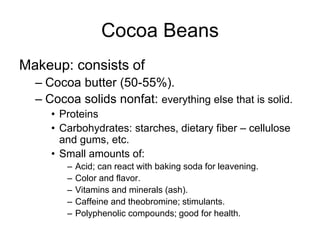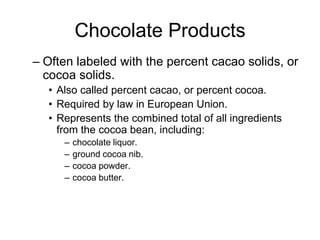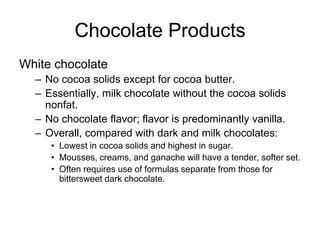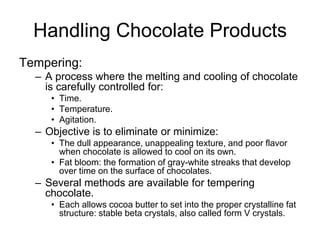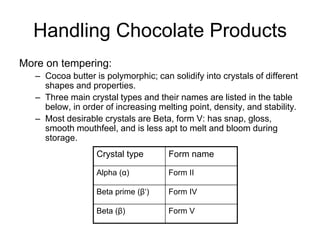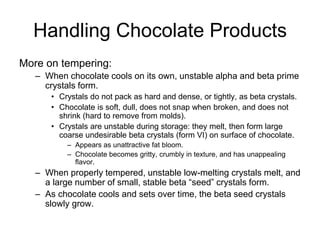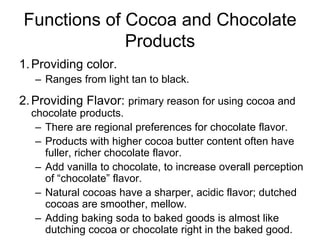Basic learning food hunger, different taste
- 1. Chapter 15 Cocoa and Chocolate Products How Baking Works
- 2. Words, Phrases, and Concepts • Cacao • Cocoa beans • Nibs • Forastero, criollo, trinitario • Cocoa solids nonfat • Cocoa product • Chocolate product • Chocolate liquor • Cocoa mass (cacaomasse) • Natural cocoa • Dutched (alkalized) cocoa Cocoa butter • Conching • Couverture • Cocoa solids • confectionery coating • Fat bloom • Tempering • Beta (Form V) crystals • Polymorphic • Sugar bloom
- 3. Introduction Cocoa beans – Also called cacao beans. – Are the beans, or seeds, of cacao tree. – Grow in hard pods. – Edible part of bean is called the nib. • Source of chocolate and cocoa.
- 4. Cocoa Beans Three main types, often blended together: – Forastero; over 90 percent of cocoa beans. • Considered “basic” or “bulk” beans. • Dark in color; strong bitter taste. • Hardy; easiest to grow. – Criollo; less than 2 percent of crop; expensive. • Considered “fine,” “flavor,” or “noble” beans. • Light in color; complex fruity aroma. • Not very hardy; difficult to grow. – Trinitario; less than 5 percent of crop. • Cross between forastero and criollo.
- 5. Cocoa Beans Makeup of cocoa beans is similar to nuts and seeds. Think of cocoa beans as real food with valuable nutrients.
- 6. Cocoa Beans Makeup: consists of – Cocoa butter (50-55%). – Cocoa solids nonfat: everything else that is solid. • Proteins • Carbohydrates: starches, dietary fiber – cellulose and gums, etc. • Small amounts of: – Acid; can react with baking soda for leavening. – Color and flavor. – Vitamins and minerals (ash). – Caffeine and theobromine; stimulants. – Polyphenolic compounds; good for health.
- 7. Cocoa and Chocolate Products Cocoa products are unsweetened. – Cocoa nibs. – Chocolate liquor. – Cocoa powder. – Cocoa butter. Chocolate products are sweetened. – Bittersweet dark chocolate and couvertures. – Milk chocolate and couvertures. – White chocolate and couvertures. Confectionary coatings. – Low-cost; contain cocoa, vegetable fats, sugar.
- 8. Cocoa and Chocolate Products • Cocoa and chocolate products are defined by law. – Definitions vary from one country to the next. – Minimizes, but does not eliminate, variation between brands. • Chocolate industry consists of: – Small operations run by skilled craftsmen, and – Large operations able to consistently manufacture moderately-priced products.
- 9. Cocoa Products Cocoa nibs – Edible part of the bean; can be purchased as small roasted pieces. – Like chopped nuts. – Makeup: same as the cocoa bean. – Unsweetened; strong bitter chocolate taste. – Use: crunchy garnish on baked goods and confections.
- 10. Cocoa Products Chocolate liquor and unsweetened chocolate – Made by finely grinding roasted nibs. – Similar to nut butters, e.g., peanut butter. • Unlike nut butters, it is solid, not spreadable. – Cocoa butter is a highly saturated solid fat. – Same makeup as cocoa beans: • 50-55% cocoa butter. • 45-50% cocoa solids nonfat. • NO sugar added. – Also called: cocoa mass, cacaomasse, bitter chocolate, baking chocolate.
- 11. Cocoa Products Chocolate liquor and unsweetened chocolate (cont.) – Sold as: • Solid blocks of about 10 pounds (5 kilograms). • Individual drops, also called coins or chips. – Use in batters and doughs of chocolate baked goods. – Can be difficult to use: melt carefully and temper into other ingredients. – Expensive compared to cocoa powder: higher in cocoa butter. – Reason to use: Has full, rich lingering chocolate flavor.
- 12. Cocoa Products Cocoa powder – Also called “cocoa.” – No sugar added. – Made by squeezing chocolate liquor in a large press. • Cocoa butter melts, some squeezes out. • “Presscake” is finely ground into cocoa powder. – Some flavor qualities lost with loss of cocoa butter. • Generally, less rich flavor than unsweetened chocolate. – Use in batters and doughs of baked goods. – Easy to use: • Sift with other dry ingredients; • Cream with shortening or other fat; or • Dissolve in hot liquid.
- 13. Cocoa Products Cocoa powder (cont.) – Categorized by: • Process: Natural or dutched. – North American consumers typically use natural cocoa. – Pastry chefs and European consumers typically use dutched. • Cocoa butter content. – Most common: » 10/12 cocoa; 10–12 percent cocoa butter, with the remaining 88–90 percent cocoa solids nonfat. » 22/24 cocoa; 22–24 percent cocoa butter; with the remaining 76–78 percent cocoa solids nonfat. – By law, American cocoa must have at least 10 percent cocoa butter; By law, European cocoa must have at least 22 percent.
- 14. Cocoa Products Cocoa powder is nutrient-rich
- 15. Cocoa Products Natural cocoa powder. – Cocoa beans not treated with alkali. – Like unsweetened chocolate, is acidic; pH between 5–6. – Sharper flavor, lighter more beige color than dutched cocoa. Dutched cocoa powder: more common in bakeshops. – Also called “cocoa processed with alkali.” – Treated with potassium carbonate or other alkali. • Treatment neutralizes natural acidity of chocolate. – Can be lightly or heavily dutched. – Has alkaline pH: typically 7–9. – Dutching alters: • Color; becomes darker and/or redder. • Flavor; is smoother, more mellow. • Solubility; disperses more easily in liquids.
- 16. Cocoa Products Switching between chocolate and cocoa: –1 pound unsweetened chocolate: • Equals 10 ounces 22/24 cocoa powder + 6 ounces shortening. –1 kilogram unsweetened chocolate: • Equals 630 grams 22/24 cocoa powder + 370 grams shortening. Shortening often reduced by one-half.
- 17. Cocoa Products Cocoa butter – Sold as pale yellow bars or flakes. • Filtered and deodorized, to remove cocoa particles and chocolate flavor. – Expensive. • Sold to cosmetics and confectionery industries. – Uses in bakeshop: • Thins out melted chocolate, for even coating and dipping. • Brushed onto pastry shells, to keep moist fillings from crisp crusts. – Highly saturated; resists oxidative rancidity. – Unique melting characteristics: very hard and brittle at room temperature; melts quickly at body temperature.
- 18. Cocoa Products Cocoa butter has a unique and pleasant mouthfeel because it melts quickly at body temperature.
- 19. Chocolate Products Chocolate products contain: – Chocolate liquor (unsweetened chocolate) • Or its equivalent (cocoa powder and cocoa butter). • White chocolate is the exception: has cocoa butter, no cocoa solids nonfat. – Sugar – Optional ingredients: • Dairy ingredients (milk, butter). • Vanillin, or other flavorings (natural or artificial). • Lecithin, or other emulsifiers. • Nuts. • Additional cocoa butter.
- 21. Chocolate Products – Are refined, by grinding finely and by conching. • Conching involves gentle heating, mixing, kneading. • For smooth flavor and mouthfeel, flowing consistency, shiny appearance. – Are tempered, or carefully melted and cooled. • To properly crystallize cocoa butter. • For best appearance, mouthfeel, and flavor. – Uses: creams, mousses, ganache fillings, etc. – Not commonly used in batters and doughs. • Refining is of no benefit to baked goods; adds cost. • Not directly interchangeable, pound for pound, with unsweetened chocolate.
- 22. Chocolate Products – Often labeled with the percent cacao solids, or cocoa solids. • Also called percent cacao, or percent cocoa. • Required by law in European Union. • Represents the combined total of all ingredients from the cocoa bean, including: – chocolate liquor. – ground cocoa nib. – cocoa powder. – cocoa butter.
- 23. Chocolate Products This chocolate product consists of 38% ingredients from the cocoa bean. The remaining 62% consists of sugar and dairy ingredients, primarily. Photo by Ron Manville
- 24. Chocolate Products Bittersweet dark chocolate – Called bittersweet or semisweet chocolate in North America. – Called dark chocolate in Europe. – If used in place of unsweetened chocolate, make adjustments for sugar. Example: For dark chocolate with 50% cocoa solids, use 2 lbs (kg) for every pound (kg) of unsweetened chocolate; reduce sugar by 1 lb (kg). Note: this is an expensive substitution.
- 25. Chocolate Products When used as a pound-for-pound direct replacement for unsweetened chocolate, dark chocolate, with its high sugar content, produces different results.
- 26. Chocolate Products Milk chocolate – Contains dairy solids in addition to cocoa solids. • Dairy ingredients are often cooked, caramelized, or ripened, for added flavor. • Dairy solids soften the “snap” of milk chocolates. – Is high in sugar; sweeter than dark chocolate. – Overall, compared with dark chocolate: • Lower in cocoa solids and higher in sugar. • Mousses, creams, and ganache will have a tender, softer set. • Often requires use of formulas separate from those for dark chocolate.
- 27. Chocolate Products White chocolate – No cocoa solids except for cocoa butter. – Essentially, milk chocolate without the cocoa solids nonfat. – No chocolate flavor; flavor is predominantly vanilla. – Overall, compared with dark and milk chocolates: • Lowest in cocoa solids and highest in sugar. • Mousses, creams, and ganache will have a tender, softer set. • Often requires use of formulas separate from those for bittersweet dark chocolate.
- 28. Chocolate Products Couverture chocolate – Couverture is French for “coating.” – Has high cocoa butter content: minimum 31 percent. – Chocolate, dark chocolate, and milk chocolate couvertures available. – Main uses: for dipping and coating; in molded chocolates.
- 29. Chocolate Products The added cocoa butter in couvertures makes them ideal for one of their main uses: dipping and coating.
- 30. Chocolate Products Confectionery coating – Also called glaze or pâte à glacer, nontempering coating, summer coating, compound coating. • Using the name “chocolate coating” is not legally correct; confectionery coating does not contain chocolate. – Contains no cocoa butter. • Instead, contains specially processed vegetable fats, such as partially hydrogenated soybean oil, or fractionated palm kernel or coconut oil. – Is to chocolate couverture what margarine is to butter. – Benefits over chocolate couverture. • Less expensive. • Easier to use: requires no tempering. • Can have a higher melting point, to resist melting in the heat. – Available as dark, milk, white coatings, and in colors.
- 31. Handling Chocolate Products To melt chocolates before use: – Use microwave oven or double boiler. – Melt carefully and do not overheat. • Can become thick, lumpy, and dull. • Easiest to overheat milk and white chocolates. – Keep water and steam away from melted chocolate. • Chocolate “seizes” in the presence of moisture – Sugars absorb water and stick, greatly increasing viscosity. • Use seized chocolate for piping, not for dipping and coating.
- 32. Handling Chocolate Products Tempering: – A process where the melting and cooling of chocolate is carefully controlled for: • Time. • Temperature. • Agitation. – Objective is to eliminate or minimize: • The dull appearance, unappealing texture, and poor flavor when chocolate is allowed to cool on its own. • Fat bloom: the formation of gray-white streaks that develop over time on the surface of chocolates. – Several methods are available for tempering chocolate. • Each allows cocoa butter to set into the proper crystalline fat structure: stable beta crystals, also called form V crystals.
- 33. Handling Chocolate Products More on tempering: – Cocoa butter is polymorphic; can solidify into crystals of different shapes and properties. – Three main crystal types and their names are listed in the table below, in order of increasing melting point, density, and stability. – Most desirable crystals are Beta, form V: has snap, gloss, smooth mouthfeel, and is less apt to melt and bloom during storage. Crystal type Form name Alpha (α) Form II Beta prime (β‘) Form IV Beta (β) Form V
- 34. Handling Chocolate Products More on tempering: – When chocolate cools on its own, unstable alpha and beta prime crystals form. • Crystals do not pack as hard and dense, or tightly, as beta crystals. • Chocolate is soft, dull, does not snap when broken, and does not shrink (hard to remove from molds). • Crystals are unstable during storage: they melt, then form large coarse undesirable beta crystals (form VI) on surface of chocolate. – Appears as unattractive fat bloom. – Chocolate becomes gritty, crumbly in texture, and has unappealing flavor. – When properly tempered, unstable low-melting crystals melt, and a large number of small, stable beta “seed” crystals form. – As chocolate cools and sets over time, the beta seed crystals slowly grow.
- 35. Handling Chocolate Products Tempering involves: – Gently heating chocolate to dissolve all crystals (T-1). – Agitating while cooling to a temperature that encourages formation of stable beta crystals (T-1 to T-2). – Warming it slightly, to melt undesirable low-melting crystals (T-2 to T-3). – Cooling gently, to set (T-3 to T-4).
- 36. Functions of Cocoa and Chocolate Products 1.Providing color. – Ranges from light tan to black. 2.Providing Flavor: primary reason for using cocoa and chocolate products. – There are regional preferences for chocolate flavor. – Products with higher cocoa butter content often have fuller, richer chocolate flavor. – Add vanilla to chocolate, to increase overall perception of “chocolate” flavor. – Natural cocoas have a sharper, acidic flavor; dutched cocoas are smoother, mellow. – Adding baking soda to baked goods is almost like dutching cocoa or chocolate right in the baked good.
- 37. Functions of Cocoa and Chocolate Products There are many reasons why cocoa and chocolate products vary in color and flavor.
- 38. Functions of Cocoa and Chocolate Products 3. Absorbing liquids. – Cocoa solids nonfat is an extremely effective drier. • Because of proteins and carbohydrates (starches and gums). • Cocoa powder absorbs more liquid than most flours. 4. Providing structure. – Cocoa solids nonfat provides structure. – Cocoa butter has about half the tenderizing power as shortening. • And provides firmness/structure as it forms solid fat crystals. 5. Providing a pleasing mouthfeel. – From unique melting characteristics of cocoa butter. 6. Adding nutritional value: cocoa beans are real food.
- 39. Storage Keep all chocolate and cocoa products: – Well-wrapped and stored in covered containers. • Keeps out rodents. • Prevents moisture pick-up, which can lead to sugar bloom. • Keeps away strong odors. – At a cool, consistent 55º–65ºF (13º–18ºC). • To prevent formation of fat bloom. Note: unless excessive, do not discard chocolate with fat bloom; baking qualities are unaffected. Milk and white chocolates have shortest shelf life. • Milk solids undergo Maillard browning at room temperature. • Milk fats undergo oxidative rancidity. • Have shelf life of 6 months to 1 year.
- 40. Storage Sugar bloom – Occurs when chocolate picks up moisture. • Sugar crystals melt, then recrystallize on the chocolate’s surface. • Remains even after chocolate is tempered. – To prevent: • Store chocolate where humidity is < 50 percent. • Use gloves when handling chocolate. • Do not warm up cold chocolate unless it is very tightly wrapped.
- 41. Storage Cocoa powder – Is hygroscopic. During storage, can • Clump. • Develop off-flavors. • Eventually mold. – Store in tightly covered container in dry area. • When properly stored, lasts for years.





